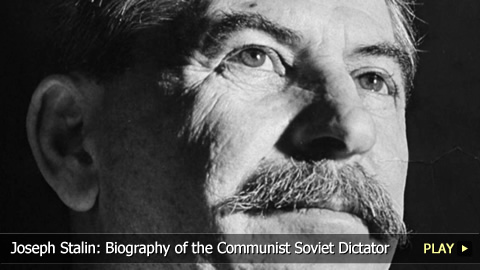Joseph Stalin: Biography of the Communist Soviet Dictator

advertisement
VOICE OVER: Rebecca Brayton
Following humble beginnings, Iosif Vissarionovich Dzhugashvili – later known as Joseph Stalin – became interested in Marxist writings. He eventually joined Vladimir Lenin's Bolsheviks, which went on to become the Communist Party of the Soviet Union. The Bolsheviks seized government control during the Russian Revolution, and it was then Stalin began to rise through the party to become its leader after Lenin's death. Stalin purged his enemies and caused millions of deaths due to famine, murder and forced labor. Though his Red Army turned the tide against the Nazis in World War II, Stalin is remembered as one of the deadliest dictators in history. In this video, http://www.WatchMojo.com learns more about the life, rule and death of Joseph Stalin.
Biography of Communist Soviet Dictator Joseph Stalin
This Soviet dictator called himself a “man of steel.” Welcome to WatchMojo.com, and today we’ll be learning more about the life of Joseph Stalin.
Early Years
Iosif Vissarionovich Dzhugashvili was born December 18th, 1878 in Gori, Georgia of the Russian Empire. Following his humble upbringing, he entered divinity school at 16 to become a priest. However, by 1899 he was kicked out due to his increasing interest in Marxist writings.
Lenin’s Bolsheviks
After discovering Vladimir Lenin’s works, Stalin became heavily involved in underground revolutionary movements. By 1903, he joined Lenin’s Bolsheviks, which later became the Communist Party of the Soviet Union.
“Stalin”
Stalin risked incarceration daily to propagandize and organize action, and his record got him exiled to Siberia several times. Around this point he adopted the name Stalin, which in Russian meant “steel.”
Russian Revolution
Lenin recognized Stalin’s contributions by appointing him to minor posts within his party. During 1917’s Russian Revolution, the Bolsheviks snatched government control, and this allowed Stalin to further increase his value. At the start of the Civil War in 1917, Stalin became the People’s Commissar for Nationalities’ Affairs, and was eventually appointed to the Political Bureau of the Central Committee of the Communist Party of the Soviet Union, or Politburo.
Communist Party Secretary
The Bolsheviks won the Russian Civil War, and aimed to expand their power in Europe by initiating the Polish-Soviet War in 1919. Stalin’s rivals criticized his choices during that war, but he redeemed himself during 1921’s Red Army Invasion of Georgia. Lenin then gave Stalin more power in 1922 by naming him Secretary for the reigning Communist Party of the Soviet Union.
Lenin’s Death
Soon after, Lenin suffered a stroke. Stalin acted as his go-between, but their relationship suffered until Lenin died of a heart attack in 1924.
Ascension to Dictator
Stalin then began his ascension: he discredited or purged rivals and intellectuals who stood in his way, like Leon Trotsky. Eventually, he was heir apparent to Soviet leadership, and by the end of the 1920s he effectively took control of the government as dictator.Five-Year Plans
In 1928, he began releasing a series of Five-Year Plans for the National Economy of the Soviet Union, which quickly increased industrialization and impelled communal farming. The Soviets prospered during this period, while capitalist countries suffered through the Great Depression; however, Stalin’s reorganization ultimately cost millions of lives due to famines, murder and the USSR’s network of forced labor, referred to as Gulag.
The Great Purge
The late-1930s was characterized by the Great Purge. This terrifying period saw the population subjected to such indignities as police scrutiny, deportation, incarceration and random murders.
World War II
In 1939, at the outset of World War II, Stalin and Hitler signed a non-aggression pact. Within two years, it became evident to everyone but the Soviet dictator that Hitler was readying to renege on that promise. Stalin and the Soviet Union were then shocked by the eventual attack.
Soviet Military Losses
Soviet forces suffered tremendous casualties until the end of 1941. This, in addition to the purges he carried out during the 1930s, meant the Red Army was lacking power and great minds.
Red Army vs. Nazis
However, Stalin finally assembled a defense: in 1943 the Red Army turned the tide against Nazi Germany and began freeing Eastern European countries. While this victory did result in massive Soviet casualties, Stalin remained steadfast.
The Big Three
Towards the war’s end, Stalin joined his other Big Three counterparts, Winston Churchill and Franklin Delano Roosevelt, and showcased his impressive negotiating skills: he successfully argued to keep countries his Red Army had liberated within Soviet power, and secured three United Nations seats for his state.
Paranoia and Death
By this point, the USSR was a respected world power. Stalin led into the nuclear age, and became increasingly mistrustful. This was exacerbated in the early 1950s by the Doctors’ Plot: this conspiracy suggested a group of primarily Jewish doctors was working together to murder important Soviets. This revelation caused Stalin to begin readying for another purge; however, on March 5th, 1953 he died without being able to implement his plan.
Legacy
In 1956, Nikita Khrushchev challenged Stalin’s accepted legacy by condemning him and his cult of personality. While Joseph Stalin is remembered by some for his contributions to Soviet industry, others decried his repressive methods and painted him as one of the most deadly dictators in history.

